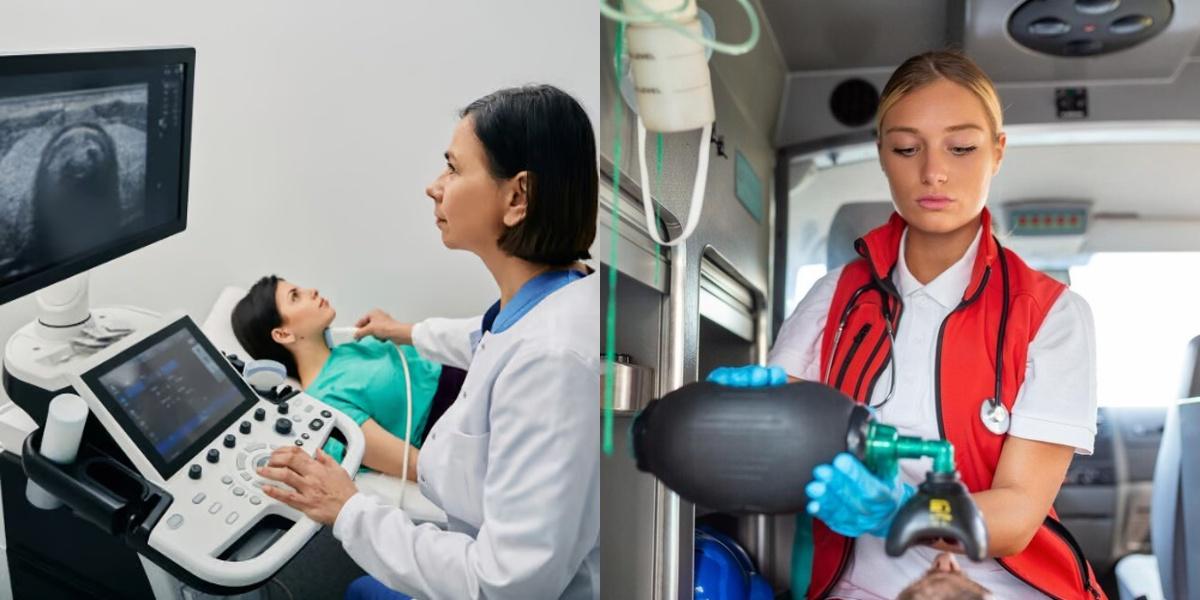Diagnostic Medical Sonographer vs Emergency Medical Technician

Key Points:
- Diagnostic Medical Sonographers use imaging equipment to create images of the body's internal structures; Emergency Medical Technicians (EMTs) provide emergency medical care and transportation.
- Diagnostic Medical Sonographers typically earn higher salaries than EMTs.
- Both fields are expected to see job growth.
- Diagnostic Medical Sonographers require an associate's or bachelor's degree, while EMTs can complete a certificate program or training course.
- Diagnostic Medical Sonographer training is generally more extensive and costly than EMT training, which can be completed in a few months.
In the field of healthcare, there are many different career paths to choose from. Two popular options are becoming a diagnostic medical sonographer or an emergency medical technician (EMT). While both professions involve working in the medical field, there are several key differences between these two careers. In this blog post, we will explore the roles and responsibilities of diagnostic medical sonographers and EMTs, as well as the education and training required for each profession. We will also discuss the career outlook and salary potential for individuals in these roles.
Diagnostic Medical Sonographer vs Emergency Medical Technician: Career Outlook and Salary
Diagnostic Medical Sonographer
- Career Outlook: The demand for diagnostic medical sonographers is projected to grow by 12% from 2020 to 2030, much faster than the average for all occupations. This growth is driven by the aging population, which will require more imaging services to diagnose and treat medical conditions.
- Salary: The median annual wage for diagnostic medical sonographers was $75,920 in May 2020, with the highest 10% earning more than $105,340. Sonographers working in hospitals tend to earn higher wages than those in physician offices or diagnostic imaging centers.
Emergency Medical Technician
- Career Outlook: The demand for EMTs and paramedics is projected to grow by 6% from 2020 to 2030, which is faster than the average for all occupations. This growth is driven by an aging population that will require more emergency medical services.
- Salary: The median annual wage for EMTs and paramedics was $36,650 in May 2020, with the highest 10% earning more than $61,330. EMTs working for local government agencies tend to earn higher wages than those employed by private ambulance services.
Final Thoughts
Both diagnostic medical sonographers and emergency medical technicians play crucial roles in the healthcare system. While diagnostic medical sonographers focus on creating images of patients' internal organs and tissues, EMTs provide immediate medical care in emergency situations. The education and training requirements for these professions differ, with diagnostic medical sonographers typically needing an associate's or bachelor's degree and EMTs entering the field with a high school diploma and completing a state-approved training program. The career outlook for both professions is positive, with job opportunities expected to grow in the coming years. Ultimately, the choice between becoming a diagnostic medical sonographer or an EMT depends on individual interests, career goals, and desired work environment.
Dreambound's programs extend across various locations. Visit these blogs for a thorough exploration of the two vocations, encompassing details on their requirements and insights on how to get started:

Stephanie Dayak is the go-to person for everything related to automation and integrations at Dreambound. As a Certified Tax Technician turned tech whiz, her sharp eye for detail and passion for efficiency become evident in every project she undertakes. When not solving tech puzzles, she's out exploring the local food scene, cozying up with her dogs, or plugged into a thought-provoking podcast. She's an ardent believer in mixing fun with functionality!



